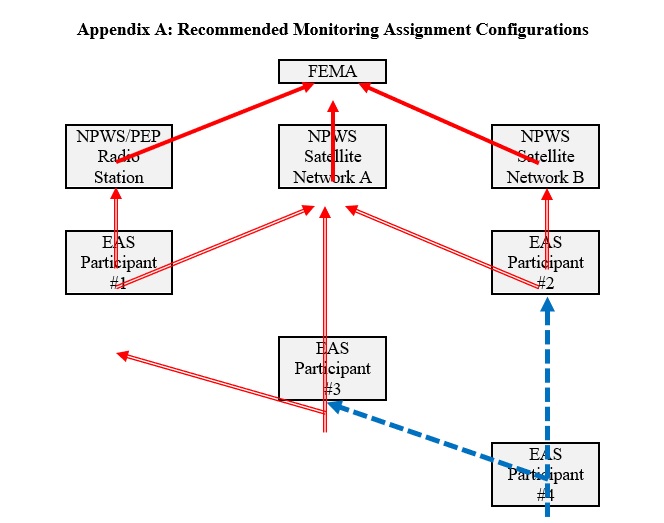Here’s an item of interest to folks who serve on State Emergency Communications Committees.
The FCC has issued a public notice with procedural changes about how state EAS plans are submitted and monitoring assignments are updated. It also recommended that state plans minimize the number of intermediate links for EAS participants to monitor their sources.
State plans describe EAS operations and lay out the responsibilities of the participants, including radio stations, to monitor signals from other participants so they can receive and transmit emergency alerts.
The notice from the Public Safety and Homeland Security Bureau outlined the following changes.
Submitting year-round
SECCs are required to update their state plans and submit them for commission approval at least annually. Previously, they could file plans in the online Alert Reporting System only once per year; after the bureau approved a plan, an SECC could make and save changes but couldn’t submit them for approval until 30 days before the next annual update was due.
The bureau says its system now will allow SECCs to submit changes and seek approval at any time; the bureau will review them as they are filed.
Use of ARS for amending monitoring assignments
SECCs will be able to submit and ask for approval for updated monitoring assignment amendments at any time. “This feature will enable SECCs to update their EAS plans for new monitoring assignments that may occur at irregular intervals and keep their plans up to date,” the commission said.
This should also make it unnecessary for SECCs or EAS participants to ask for waivers to obtain approval of the changes before the annual update. “Although the traditional monitoring waiver process will continue to be available, the bureau encourages SECCs to use the newly automated EAS plan amendment process incorporated into ARS whenever possible.”
It wants EAS participants to begin monitoring new EAS sources that they can reach immediately when they can no longer receive an old source reliably, without waiting for formal approval.
“This monitoring assignment amendment option will be available to SECCs that are submitting or have already submitted complete EAS plans in ARS. A monitoring assignment amendment submission will be treated as a newly submitted EAS plan. If the bureau approves the submission, the SECC will be considered to have satisfied its annual filing requirement for another year.”
The bureau also suggested that SECCs seeking monitoring amendments identify the EAS participants whose monitoring assignments are being modified and the proposed new assignments.
Planned Monitoring Assignment Changes
The commission also clarified that any EAS plan filing may contain monitoring assignments that EAS participants are in the process of carrying out but have not yet fully implemented.
For example, if the SECC has assigned or is in the process of assigning a satellite monitoring source to an EAS participant but the participant hasn’t acquired the receiver equipment yet, the SECC may include the planned assignment in its plan submission in the appropriate monitoring table.
SECCs submitting these monitoring assignments should indicate in an attachment which assignment changes have not yet been implemented and the date they’re expected to be complete. If something changes, SECCs should update and resubmit their plans promptly.
Simplifying EAS Monitoring Assignments
To keep things moving along, the bureau also recommended that SECCs configure their monitoring assignments by assigning as many EAS participants as possible to directly monitor (with no intermediate links) one or more sources that receive the National Emergency Message (EAN) signal directly from the Federal Emergency Management Agency.
It pointed out that the 77 radio stations and three satellite networks that make up the National Public Warning System (NPWS) — previously known as the Primary Entry Point (PEP) system — deliver the EAN alert from FEMA to EAS participants.
The broad coverage of those sources should make it possible for most participants to monitor signals from one or more of them directly, regardless of whether the participants are designated as Local Primaries, Participating Nationals or any other status in the EAS plan.
“The bureau recommends that EAS plans, whenever possible, minimize the number of intermediate links for EAS participants to monitor such sources.” It provided the graphic below showing recommended configurations of monitoring assignments.
Recommended Monitoring Assignment Configurations

The diagram shows two EAS participants that directly monitor signals from two FEMA-designated NPWS sources: EAS participant #1 monitors an NPWS/PEP radio station and an NPWS satellite network, while EAS participant #2 monitors two different NPWS satellite networks.
Participant #3 directly monitors signals from one NPWS source (a satellite network) and indirectly monitors signals from a different NPWS source by directly monitoring participant #1, which in turn directly monitors the NPWS/PEP radio station.
“While the rules permit assignments like those shown for EAS participant #4 in the illustration, which directly monitors signals from two EAS participants with diverse connections to different NPWS sources (thus avoiding any potential single points of failure), such arrangements are not ideal,” the FCC wrote.
“If possible, most EAS participants should have at least one direct monitoring connection to an NPWS source, like EAS participant #3 in the diagram; or two such direct connections, like EAS participants #1 and #2. As shown in the diagram, EAS participant #4 has no such direct connections and therefore it needs multiple intermediate connections to pick up the EAN signal from FEMA. While this arrangement is permissible under the rules, it is not preferred because it is more likely to result in audio signal attenuation or loss and increases the risk of transmission failure through multiplication of links.”









